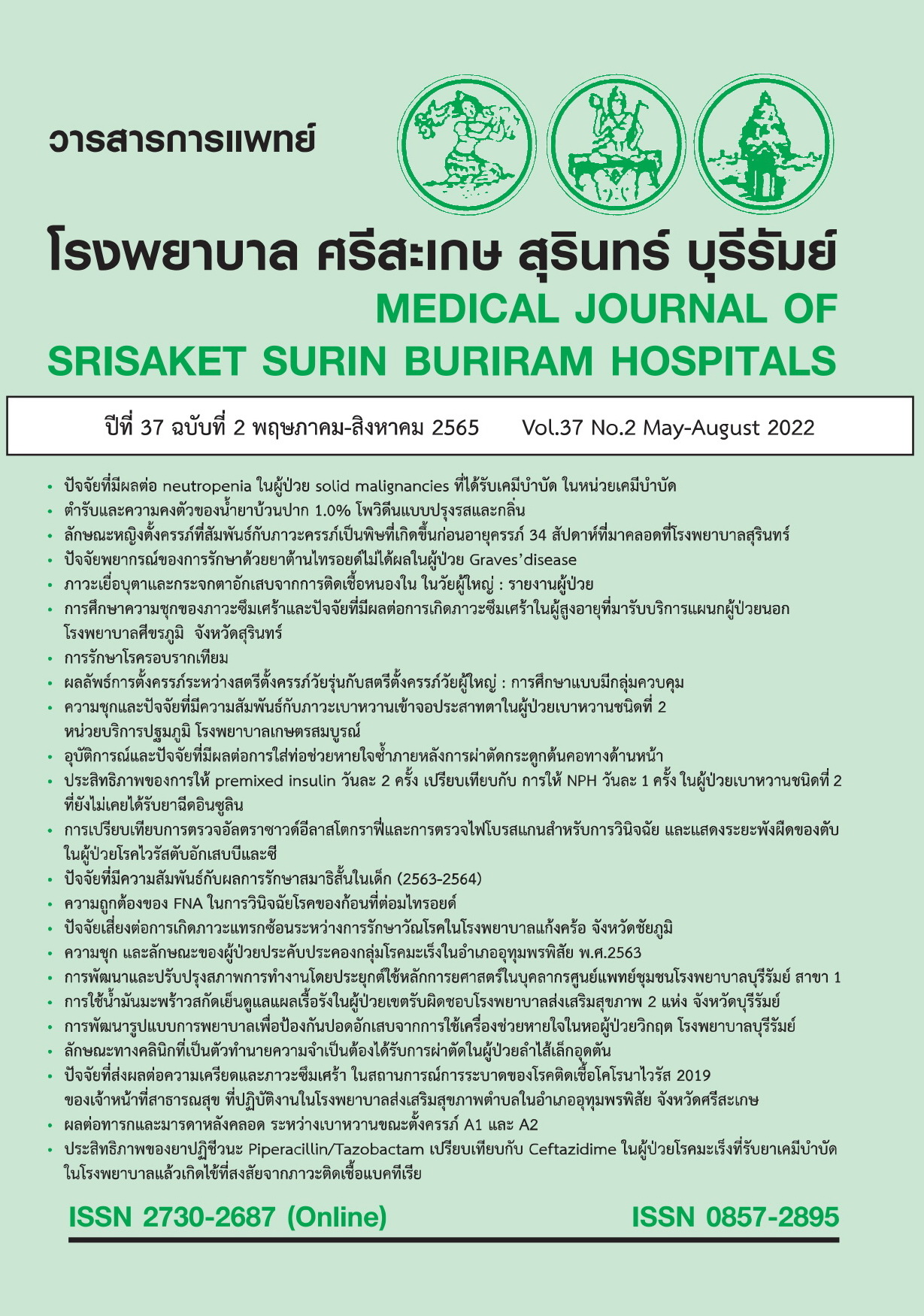ประสิทธิภาพของยาปฏิชีวนะ Piperacillin/Tazobactam เปรียบเทียบกับ Ceftazidime ในผู้ป่วยโรคมะเร็งที่รับยาเคมีบำบัดในโรงพยาบาลแล้วเกิดไข้ที่สงสัยจากภาวะติดเชื้อแบคทีเรีย
Main Article Content
บทคัดย่อ
หลักการและเหตุผล: ภาวะไข้ที่เกิดในผู้ป่วยโรคมะเร็งหลังได้รับยาเคมีบำบัด พบได้บ่อยและมีความสำคัญ เนื่องจากผู้ป่วยมีโอกาสติดเชื้อแบคทีเรียที่รุนแรงได้ ปัจจุบันยังไม่มีแนวทางการใช้ยาปฏิชีวนะแบบครอบคลุมในผู้ป่วยกลุ่มนี้ แพทย์ส่วนใหญ่จึงปฏิบัติตามแนวทางของภาวะ febrile neutropenia นอกจากนี้ราคายายังเป็น ปัจจัยที่ต้องพิจารณาซึ่ง piperacillin/tazobactam มีราคาที่สูงกว่า ceftazidime และยังไม่มีงานวิจัยที่ศึกษาว่าการเริ่มต้นด้วยยาชนิดใดให้ผลที่ดีกว่า
วัตถุประสงค์: เพื่อเปรียบเทียบประสิทธิภาพและค่าใช้จ่ายที่เกิดขึ้น ระหว่างผู้ป่วยที่ได้รับpiperacillin/tazobactam หรือ ceftazidime เป็นยาปฏิชีวนะแบบครอบคลุมตัวแรก
รูปแบบศึกษา: เป็นการศึกษาเชิง therapeutic รูปแบบ observational retrospective cohort ในผู้ป่วยโรคมะเร็งอายุ 15 ปีขึ้นไป ที่มารับยาเคมีบำบัดแบบผู้ป่วยใน โรงพยาบาลสุรินทร์ แล้วเกิดไข้ที่สงสัยจากภาวะติดเชื้อแบคทีเรียและได้รับยาปฏิชีวนะแบบครอบคลุม piperacillin/tazobactam หรือ ceftazidime อย่างน้อย 24 ชั่วโมง ระหว่างวันที่ 1 มกราคม พ.ศ. 2561 ถึงวันที่ 31 ธันวาคม พ.ศ. 2563
วิธีการศึกษา: เก็บข้อมูลพื้นฐาน ผลตรวจทางห้องปฏิบัติการ ยาปฏิชีวนะที่ใช้และค่าใช้จ่ายด้านยา จากเวชระเบียนผู้ป่วยใน วิเคราะห์ด้วยสถิติเชิงพรรณนาและเชิงอนุมานด้วย Chi-square test สำหรับข้อมูลแบบสัดส่วน independent t-test หรือ Mann-Whitney U test สำหรับข้อมูลต่อเนื่อง
ผลการศึกษา: จำนวนผู้ป่วยที่ได้รับยาปฏิชีวนะ piperacillin/tazobactam 11 ราย และ ceftazidime 72 ราย ลักษณะพื้นฐานของทั้งสองกลุ่มไม่แตกต่างกัน ยกเว้นในกลุ่ม piperacillin/tazobactam พบตำแหน่งของการติดเชื้อที่มากกว่า (p=0.032) ในเรื่องประสิทธิภาพพบว่าจำนวนวันที่ใช้ยาปฏิชีวนะวันแรกจนผู้ป่วยได้จำหน่ายออกจากโรงพยาบาลมีค่ากลางที่ 3 วัน ไม่แตกต่างกัน (p=0.615) ค่าใช้จ่ายของยาปฏิชีวนะ piperacillin/tazobactam เท่ากับ 1110 บาท (IQR 888, 2696) ceftazidime เท่ากับ 553 บาท (IQR 420, 859) ซึ่งแตกต่างกัน (p=0.005) และค่าใช้จ่ายรวมของยาปฏิชีวนะทั้งหมดที่ใช้ในกลุ่ม piperacillin/tazobactam เท่ากับ 1349 บาท (IQR 1209, 6140) ceftazidime เท่ากับ 790 บาท (IQR 537, 1153) บาท มีความแตกต่างกันทางสถิติ (p=0.001)
สรุป: ผู้ป่วยโรคมะเร็งที่อยู่ระหว่างการรับยาเคมีบำบัดแบบผู้ป่วยใน เมื่อมีไข้ที่สงสัยจากภาวะติดเชื้อแบคทีเรีย อาจพิจารณาให้ยาปฏิชีวนะแบบครอบคลุมด้วย ceftazidime ได้ เนื่องจากผลลัพธ์ทางคลินิกไม่ต่างจาก piperacillin/tazobactam แต่มีค่าใช้จ่ายที่ถูกกว่า
Article Details

อนุญาตภายใต้เงื่อนไข Creative Commons Attribution-NonCommercial-NoDerivatives 4.0 International License.
เอกสารอ้างอิง
Krzyzanowska MK, Walker-Dilks C, Atzema C, Morris A, Gupta R, Halligan R, et al. Approach to fever assessment in ambulatory cancer patients receiving chemotherapy: a clinical practice guideline. Curr Oncol 2016;23(4):280-5. doi: 10.3747/co.23.3098.
Klastersky J, de Naurois J, Rolston K, Rapoport B, Maschmeyer G, Aapro M, et al. Management of febrile neutropaenia: ESMO Clinical Practice Guidelines. Ann Oncol 2016;27(suppl 5):v111-v118. doi: 10.1093/annonc/mdw325.
Tabor PA. Drug-induced fever. Drug Intell Clin Pharm 1986;20(6):413-20. doi: 10.1177/106002808602000601.
Khurana A, Mitsis D, Kowlgi GN, Holle LM, Clement JM.Atypical presentation of fever as hypersensitivity reaction to oxaliplatin. J Oncol Pharm Pract 2016;22(2):319-24. doi: 10.1177/1078155214558350.
Ogawara D, Fukuda M, Ueno S, Ohue Y, Takemoto S, Mizoguchi K, et al. Drug fever after cancer chemotherapy is most commonly observed on posttreatment days 3 and 4. Support Care Cancer 2016;24(2):615-9. doi: 10.1007/s00520-015-2820-8.
Callen JP, Keskey K. Fever as a complication of low dose irradiation. Br J Radiol 1977;50(590):146-7. doi: 10.1259/0007-1285-50-590-146.
Rolston KV. Neoplastic fever: all who shiver are not infected. Support Care Cancer 2005;13(11):863-4. doi: 10.1007/s00520-005-0863-y.
Johnson M. Neoplastic fever. Palliat Med 1996;10(3):217-24. doi: 10.1177/026921639601000306.
Klastersky J, Paesmans M, Rubenstein EB, Boyer M, Elting L, et al. The Multinational Association for Supportive Care in Cancer risk index: A multinational scoring system for identifying low-risk febrile neutropenic cancer patients. J Clin Oncol 2000;18(16):3038-51. doi: 10.1200/JCO.2000.18.16.3038.
Freifeld A, Marchigiani D, Walsh T, Chanock S, Lewis L, Hiemenz J, et al. A double-blind comparison of empirical oral and intravenous antibiotic therapy for low-risk febrile patients with neutropenia during cancer chemotherapy. N Engl J Med 1999;341(5):305-11. doi: 10.1056/NEJM199907293410501.
National Comprehensive Cancer Network. Prevention and Treatment of Cancer-Related Infections [Internet]. 2022 [cited 2022 April 2]. Available from:URL: https://www.nccn.org/professionals/physician _gls/pdf/infections.pdf
Eroglu N, Erduran E, Reis GP, Bahadır A. Chemotherapy-related fever or infection fever? Support Care Cancer 2021;29(4):1859-62. doi: 10.1007/s00520-020-05670-z.


